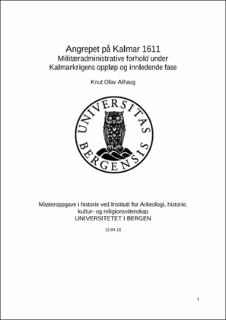| dc.description.abstract | The purpose of this thesis has been to explore the state of military- and administrative development in the kingdom of Denmark at the outset of the Kalmar War in 1611; and to do so through the perspectives of theories on the development in warfare, military-enterprise, and state organizational structures.
The early modern period saw the abolishment of feudal state-structures in favour of modern nation-states, where economical- and military power were held centrally by the state and not by the nobility as independent or semi-independent military-economical entities. This development is characterized by the state enacting and establishing greater control over its subjects, incorporating them into the expanding administrative structure.
The Military Revolution theory, first coined by Michael Roberts during his lecture at The Queen`s University Belfast in 1955, seeks to explain the rise of the modern state through the lens of military development in the early modern period. In Roberts view, the complexity and demands of early modern warfare forced European states to expand their control over state-resources, human and material.
While Roberts focused on the development of military tactics, technology and the increasing scale of warfare, Geoffrey Parker expanded on the thesis by supplying factors like fortifications and naval warfare. Whereas the early modern state often lacked in own resources to effectively supply its need in warfare, there existed a transnational network of military enterprisers ready to supply waring states with mercenaries and experienced officers.
This element of military enterprise has been investigated by David Parrot, who besides describing the different forms of military-entrepreneurship, argues that the increase in mercenary availability forced European states into creating more cost-efficient standing armies. Thus, adding a new layer to the theory of military revolution in early modern Europe, as well as outlaying a new aspect of military development regarding the rise of the modern nation-state.
By exploring written sources from the period, letters, journals, and bills of recruitment, I have sought to inquire on the following: To which degree the Danish state in 1611 reflects the tactical and organizational developments in warfare, as documented in continental Europe at the time. Secondarily, whether or not the Danish practice of mercenaries reflects the development and patterns of military-enterprise in early modern Europe.
This thesis finds that military-enterprise were well established within the Danish state, though at a smaller scale and lesser level of economical independence than seen during the Thirty Years´ War, with the military contractors relying on danish monetary payments in order to make recruitments. These mercenary contractors worked symbiotically within the Danish military-administrative system, as the established structure for mustering of soldiers did not discriminate between foreign contractors and Danish officers.
The Danish forces were diversely comprised, with elements of recruited Danish infantry, traditional feudal services restructured as more modern cavalry units, foreign mercenaries, as well as units of forcibly mustered Norwegian peasants. Amongst these, the foreign mercenary units proved themselves reliable in combat and were highly valued, as shown in the chapter 4. combat analyses.
The danish military-administrative system largely reflects the European military developments of its age, though the elements of military enterprise appear more in line with 16th century modes of operation than those of the mercenary heydays of the 17th century. | en_US |
